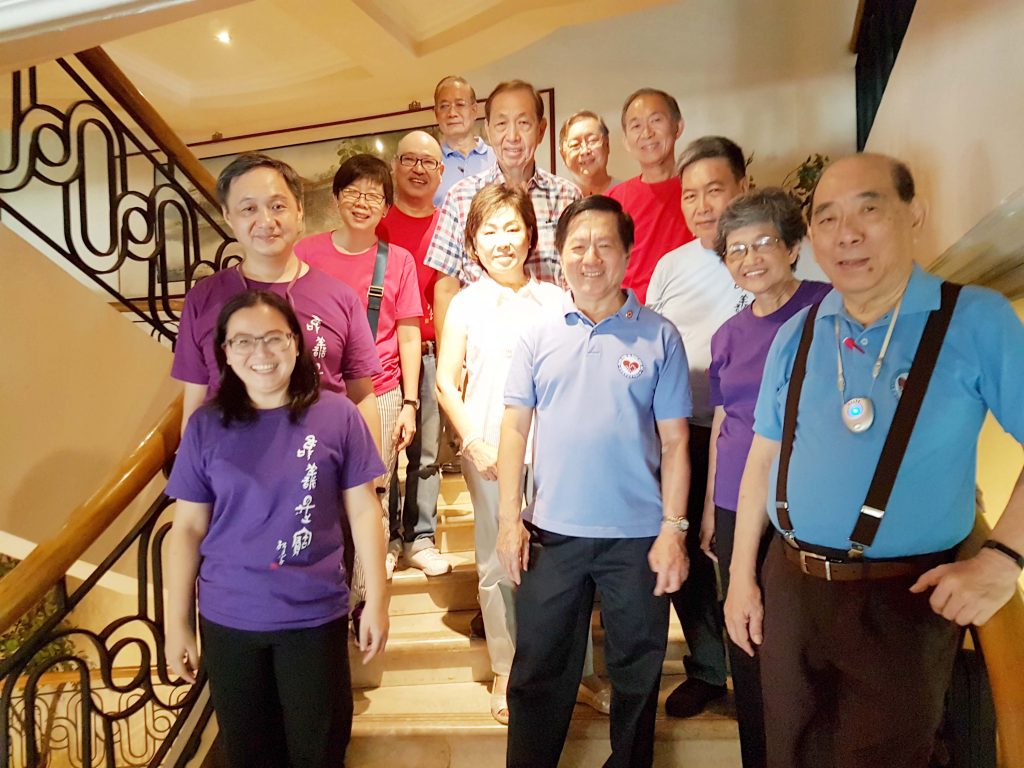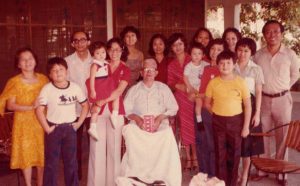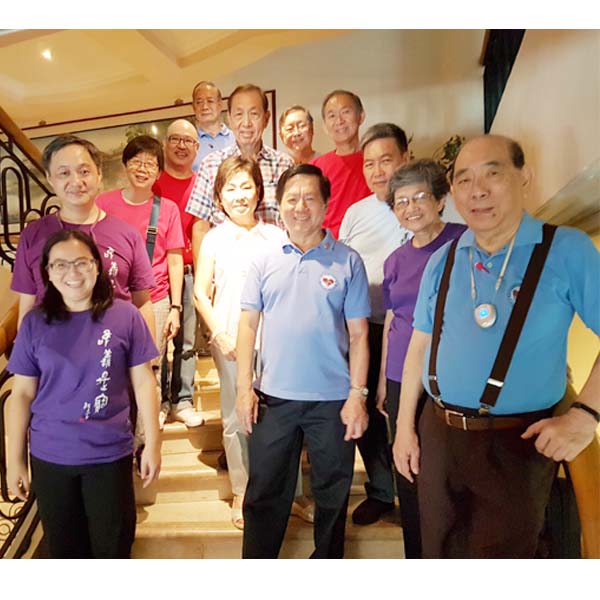
Kaisa Song
Ito ang Pilipinas, bayan naming mahal
Ito ang lupaing sa ami’y nagsilang
Pulo nito at bayan ang aming tahanan
Ito’y langit namin, pag-asa at hirang
Mga puso nami’y kaisa ang pintig
Minimithi namin matindig ang lahi
Kasama n’yo kami, laging kaagapay
Sa lahat ng hamon at unos ng buhay
Kami’y kaisa ninyo! Kasalo at kasama
Mga palad natin ay magkakaugnay
Iisa lang ang ating pag-asa at tagumpay
Yumabong, bumulas lupang tinubuan
Kami’y kaisa ninyo kalahi at kabayan
Mga palad natin ay magkakaugnay
Iisa lang ang ating hangarin at damdamin
Kaisa! Kaisa! Hanggang sa tagumpay!
Kaisa’s haunting theme song, its lyrics by renowned writer, the late Rene O. Villanueva, and music by Archie Castillo, reflects the motivating force behind the organization and the essence of being a Kaisa member – the desire to be one with the Filipino community in rebuilding our nation and finding our rightful place in the Philippine sun.
From the ruins wrought by the conjugal dictatorship of Ferdinand and Imelda Marcos, Kaisa Para Sa Kaunlaran was born 30 years ago on Aug. 28, 1987, a year after the EDSA People Power Revolution.
Though Kaisa’s 30-year journey had branched into many untrodden paths, we remain true to our mission – the political, economic and socio-cultural integration of Tsinoys into the mainstream society. We triumphed over unexpected challenges and hurdled seemingly insurmountable difficulties.
And throughout this eventful journey, members, supporters, fellow travelers and believers joined us in our cause and truly became the wind beneath our wings.

Untrodden paths
The first 10 years were filled with ground-breaking activities, daring to venture where others would not. We published Integration (融合 Yong Hap), a weekly Sunday Chinese supplement in World News, the leading Chinese daily, as soon as we launched Kaisa. It is now on its 1,552 issue (as of Sept. 3). The publication is meant for the Tsinoys, especially the older generation, to appreciate Filipinos and to understand Tsinoy’s history mainstream concerns and issues better.
Tulay (橋) came out in 1988, with its mission on its masthead – “A bridge of understanding between two cultures; a bridge of tolerance between two ages.” It was meant to be a link to enlighten the younger generation to appreciate their past and the cultural legacy bequeathed by their ancestors.
We also started Kaisa research and publications and came out with our first book, Heritage: A pictorial history of the Chinese in the Philippines in 1988, which became the concept for putting up the Bahay Tsinoy, a museum of the Chinese in Philippine Life. We were also the founding members of PACS (Philippine Association for Chinese Studies) in 1987.
At the first PACS conference in 1988 held at De La Salle University, I delivered a talk on “The Chinese in the Philippines – Assets or Liabilities.” The late Miriam Defensor Santiago, then Immigration commissioner, was my paper reactor.
The paper became Santiago’s key reference for a significant policy (Executive Order 324) that legalized the status of overstaying Chinese, who were perennial milking cows of unscrupulous immigration agents. These Chinese, many of whom have been in the Philippines for two to three decades, were deeply grateful for Kaisa’s efforts and gave Kaisa a plaque of appreciation.
On international linkages, we hosted an international conference on the Chinese in Southeast Asia in 1992 and hosted the third international conference of the International Society for the Study of the Chinese Overseas (ISSCO) in 1998. These two conferences raised us to the consciousness of an international group of researchers, scholars and enthusiasts on the study of Chinese overseas.
We also started our Alay Medisina, giving medicine to indigent patients at the Philippine General Hospital. This was followed by Alay Puso, giving basic supplies to the Mother Teresa Centers in Del Pan and in Dagupan. Alay Dunong later replaced Alay Puso, a project supplying skills training to high school students who may be unable to go to college and to indigenous minorities in Mindoro and Bataan.
In between were the many outreach projects for fire victims, vaccination for children at Barangay Tatalon, many of whom died of measles, and the much bigger calamity outreach, the Baguio-Dagupan earthquake of 1991 and Pinatubo eruption of 1992.
The Skills and Entrepreneurship Training project for 10 public schools, launched in 1990, produced solid results. High schools students who could not afford to go to college, were introduced to vocational skills, which they can use for livelihood projects. These include training in catering, baking, sewing, upholstery making, refrigeration, hair styling and other skills.
Trail blazing anti-crime efforts
We never imagined that our advocacy would one day give a voice and a face to kidnap victims. Near the end of Cory Aquino’s administration, Kaisa had started recording the increasing number of kidnapping incidents which was much talked about within the Tsinoy community but remained unreported to the police.
In September 1992, two young boys, aged 17 and 18, were brutally tortured and killed even after their parents paid a huge ransom. It jolted the Tsinoy community, who always thought that one can waste money to dispel misfortune (失錢消災). They paid ransom and wasted money – but the boys still lost their lives.
Kaisa attempted to mobilize the Tsinoy community to express indignation but the time apparently had not yet come. This first attempt failed.
On Jan. 7, 1993, 15-year-old Charlene Sy was abducted on her way to school, and subsequently killed – shot dead in a bungled police rescue attempt. Her body, still in her bloodied uniform, was laid side by side with her kidnappers in full view of the world.
Feeling the rage and pain of the community, Kaisa knew it was now or never. A meeting of different groups was called and the groups met outside Charlene’s wake. Kaisa organized a mass funeral protest rally, which became a breakthrough milestone in the Tsinoy community.
Under the aegis of Movement for Restoration of Peace and Order, with the slogan, “After Charlene, Who’s Next?”, 200 Tsinoy organizations joined the march. Kaisa called for a day of mourning, and the Tsinoy community responded: all Tsinoy schools and Tsinoy shops in Binondo and Banawe closed.
I became the face and the voice of the pain and rage of the Tsinoys. I was interviewed by local and international media and I appeared before the Senate hearing. It was not without risk. My family and I were besieged with nightly threats. I had to move residences and relocated my children to a friend’s house. I had to apologize to my kids for bringing misery and unparalleled restrictions into their young lives.
Indelible footprints in history
Our anti-crime efforts brought Kaisa into greater prominence, but there was no joyful triumph. With all board members beside and behind me, we ventured where others feared to tread. That was, and is, the Kaisa spirit.
The dedication and commitment of members who toil silently without thought of recognition or reward paid off when we started the fund raising campaign to build our biggest bridge, the Kaisa Heritage Center, the Bahay Tsinoy – Museum of the Chinese in Philippine Life, the Kaisa Research Center and Data Bank, the Chinben See Memorial Library, Benito Cu-Uy Gam Hall, Jimmy Ongking Hall, Awat Keng Auditorium, Ching Ban Lee Ceramics Gallery, Ching Han Sui Board Room, Tan Eng Gee Hall, Antonio Roxas Chua Hall, Teh Siu Yong Limpe Hall, Dr. Pao Shih Tien Hall – all housed under the Kaisa-Angelo King Heritage Center building.
Kaisa received the overwhelming support of the Tsinoy community due to their desire to be part of the endeavor to build a Tsinoy community cultural center.
Kaisa Heritage Center now serves as a valuable repository of the historical and cultural legacies of the Tsinoys in all aspects of Philippine life. It is recognized as a Philippine history museum with the focus on the influence and impact of the Chinese Filipinos in events that helped shape the Philippines as a nation. The special collections of the Chinben See Memorial Library on the Chinese overseas studies are highly praised by renowned scholars in this field of study. Doctoral dissertations and masteral theses have cited the library collections as a valuable resource.
The Ching Ban Lee Ceramics Gallery is unique in Southeast Asia: it has pieces produced from the most important kilns in southern China. These are significant, albeit silent, evidence of the extensive and intensive trade with China long before the advent of colonial administration.
One significant legacy of Kaisa is in the linguistic arena: there is a conscious determination not to use the term huan-ah to refer to Filipinos, to correctly use the term Chinese-Filipino instead of Filipino-Chinese, and to refer to Chinese Filipinos as huaren (ethnic Chinese) and not huaqiao (sojourners). Most importantly, Kaisa coined and propagated the word Tsinoy, now widely accepted in Filipino lexicon. These have definitely left a permanent imprint in Philippine history.
Overcoming new challenges
It’s been 30 years since Kaisa’s inception in 1987. When I was elected president, I was most apprehensive and very reluctant to accept the responsibility. My son was barely 2 years old, my daughter was 9 and I was newly widowed.
I tearfully begged off from being president because at the time, I didn’t know what future awaited me and my children. But, what was dinned into my mind was the saying that in the forest with no lions, the monkey can be king.
The board felt that I was the only one at that time qualified to lead and bind the different groups together as one Kaisa.
Above all, I myself firmly believed that not everyone is given the privilege to be of service and he who is given that chance should seize it. My founding board fully committed to help me bear the responsibility of building Kaisa, and through them, we were able to tap the Tsinoy community’s help to carry on with our tasks and fulfill our mandate.
Today, Kaisa has truly passed on the torch to the next generation. My daughter has been elected Kaisa president. Though the physical conditions for running the organization are much better than when we first started in our borrowed office, the burden is nevertheless heavier, the tasks bigger and more complicated.
From a two-room office, we now have a three-storey building and a world-class museum to maintain. She faces new and more daunting challenges.
One such challenge is what many other Tsinoy organizations face – whether Kaisa as an organization is still relevant – as the younger generation feel that Kaisa is not needed anymore. Most now participate fully in mainstream society and their concerns have gone beyond just the Tsinoy community.
The financial challenge of professionalizing Kaisa, the organization, remains pressing. There is an urgent need to hire more professional paid staff and organize volunteers better.
Among these tasks is that of being the secretariat for MRPO in its anti-crime efforts and up to June last year, Kaisa was also the secretariat for ISSCO. Kaisa’s small staff attends to a myriad of activities and multi-tasks considerably, but this is becoming increasingly more difficult.
Through all these challenging times, we are comforted by our many generous supporters and advocates in their continued belief and support – both financial and moral – to our cause. Together, we face another 30 years of overcoming challenges and triumphs and hope that Kaisa will continue to get the full support – financial and moral – it needs from the Tsinoy community.
